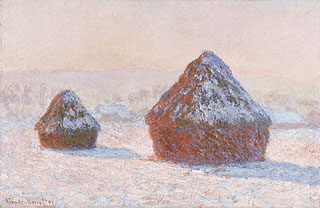• What colors has the artist used to paint this picture? (While we often think of snow as white,
there is no pure white in this painting, but variations of light blues, pinks, and yellows. In the wheatstacks,
numerous colors can be seen.) What colors are visible in the shadows of the wheatstacks?
(In this work the shadows appear blue; we often think of shadows as gray or black, but often shadows reflect
the colors of objects around them.)
• What shapes and forms can you identify in this painting?
• How would you describe the objects in the foreground? (Although these might look like muffins, cupcakes, or grass huts,
they are actually wheatstacks.)
• What can you see in the
middle ground and
background of the painting?
• What time of day was it when this painting was made? How do the shadows work to tell us what time of day it is in
the painting?
• Why do you think the artist chose to paint wheatstacks as his subject? Monet painted these same wheatstacks near
his home at least 30 times in less than a year. Why do you think he chose to paint the same wheatstacks over and over?
(He was interested in studying the wheatstacks in light at different times of day and in different seasons.) |
In the fall of 1890, Impressionist painter Claude Monet paid to have the wheatstacks near his home in Giverny left out over
the winter. By the following summer he had painted them at least 30 times, at different times throughout the seasons.
Wheatstacks was Monet's first series and the first in which he concentrated on a single subject, differentiating pictures
only by color, texture, composition, lighting, and weather conditions. He said, "For me a landscape hardly exists at all
as a landscape, because its appearance is constantly changing; but it lives by virtue of its surroundings, the air and
the light which vary continually."
After beginning outdoors, Monet reworked each painting in his studio to create the color harmonies that unify each canvas.
The pinks in the sky echo the snow's reflections, and the blues of the wheatstacks' shadows are found in the wintry light
shining on the stacks, in the roofs of the houses, and in the snowy earth. With raised, broken brushstrokes, Monet captured
nuances of light and created a solid, geometric structure that prevents the surface from simply melting into blobs.
The wheatstacks are solid forms, and, while the outlying houses are out of focus when viewed close-up, they are clear from
a distance.
About the Artist
"Merely think, here is a little square of blue, here an oblong of pink, here a streak of yellow, and paint it just as it
looks to you," advised Claude Monet. He was a successful caricaturist in his native Le Havre, but after studying plein-air
painting, he moved to Paris in 1859. He soon met future Impressionists Camille Pissarro and Pierre-Auguste Renoir.
Renoir and Monet began painting outdoors together in the late 1860s, laying the foundations of Impressionism.
In 1874, with Pissarro and Edgar Degas, Monet helped organize the Société Anonyme des Artistes, Peintres, Sculpteurs,
Graveurs, etc., the formal name of the Impressionist group.
During the 1870s Monet developed his technique for rendering atmospheric outdoor light, using broken, rhythmic brushwork.
He received little but abuse from the public and critics alike, who complained that his paintings were formless, unfinished,
and ugly. He and his family endured abject poverty. By the 1880s, however, his paintings started selling;
Pissarro accused him of commercialism, and younger painters called him passé, for he remained loyal to the
Impressionists' early goal of capturing the transitory effects of nature through direct observation.
In 1890 he began creating paintings in series, depicting the same subject under various conditions and at
different times of day. His late pictures, made when he was half-blind, are shimmering pools of color almost
totally devoid of form. |
